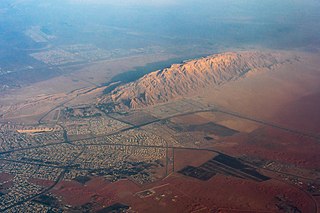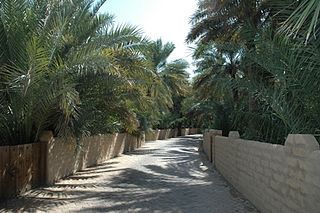
The United Arab Emirates is a country in the eastern part of the Arabian Peninsula located on the southeastern coast of the Persian Gulf and the northwestern coast of the Gulf of Oman. The UAE consists of seven emirates and was founded on 2 December 1971 as a federation, after UK armed forces left the region. Six of the seven emirates declared their union on 2 December 1971. The seventh, Ras al Khaimah, joined the federation on 10 February 1972. The seven sheikdoms were formerly known as the Trucial States, in reference to the truce treaties established with the British in the 19th century.
This article covers the various forms of transport in the United Arab Emirates (UAE), by road, rail, air, water, etc.

Al Ain is a city in the Emirate of Abu Dhabi, United Arab Emirates and the seat of the administrative division of the Al Ain Region The city is bordered to the east by the Omani town of Al-Buraimi. Al Ain is the largest inland city in the Emirates, the fourth-largest city, and the second-largest in the Emirate of Abu Dhabi. The freeways connecting Al Ain, Abu Dhabi, and Dubai form a geographic triangle in the country, each city being roughly 130 kilometres (81 mi) from the others.

Jabal Hafeet is a mountain in the region of Tawam, on the border of the United Arab Emirates and Oman, which may be considered an outlier of the Hajar Mountains in Eastern Arabia. Due to its proximity to the main Hajar range, the mountain may be considered as being part of the Hajar range. To the north is the UAE city of Al Ain, in the Eastern Region of the Emirate of Abu Dhabi, and the adjacent Omani town of Al-Buraimi.

Sir Abu Nuʽayr, also known as Sir Bu Nuʽayr, or Sir al Qawasim is an island in the Persian Gulf.

The culture of the United Arab Emirates is part of the culture of Eastern Arabia. Its historical population was a small tribal community that changed with the arrival of an influx of foreign nationals in the mid-20th century. Emirati culture is a blend of Arabian, Islamic, and Persian cultures, with influences from the cultures of East Africa and Indian Subcontinent. Islam has had a prominent influence on local architecture, music, attire, cuisine, and lifestyle.

Al-Ain Oasis is the largest oasis in the city of Al Ain, within the Eastern Region of the Emirate of Abu Dhabi, the United Arab Emirates.

Al Ain Museum, also known as Al Ain Museum, is a museum in the city of Al Ain, within the Emirate of Abu Dhabi, the United Arab Emirates.

Sheikh Zayed Palace Museum, also known as "Al Ain Palace Museum", is a museum in the city of Al Ain, within the Emirate of Abu Dhabi, United Arab Emirates.
Cultural policy in Abu Dhabi, a city within the United Arab Emirates, refers to any initiative undertaken by the Emirate government aimed at achieving goals to contribute to or shape culture. Abu Dhabi's government aims to develop a cultural infrastructure that will allow it to establish itself as a reference point for culture on three levels:

The Hafit period defines early Bronze Age human settlement in the United Arab Emirates and Oman in the period from 3200 to 2600 B.C. It is named after the distinctive beehive burials first found on Jebel Hafit, a rocky mountain near Al Ain, bordering the Rub Al Khali desert. Hafit period tombs and remains have also been located across the UAE and Oman in sites such as Bidaa bint Saud, Jebel Buhais and Buraimi.
Bidaa Bint Saud is an archaeological site in Eastern Region of the Emirate of Abu Dhabi, the U.A.E., notable for its Hafit Period tombs, Iron Age irrigation systems and rare remains of an Iron Age building thought to have been a distribution centre for water from two aflaj. It is a listed UN World Heritage Site. Finds from the site are displayed at Al Ain National Museum.

Qattara Oasis is an area of irrigated date farm in Al Ain, United Arab Emirates featuring a distinctive falaj irrigation system as well as a late Bronze Age archaeological site dated to 1800–1500 BCE. The oasis has been extensively surveyed by students from Al Ain University since 2015, and is home to 19 buildings of varying antiquity, of which nine are mosques. Among these are thought to be some of the oldest buildings still standing in Al Ain.

The Eastern Region, officially known as Al Ain Region, is one of three Municipal Regions in the Emirate of Abu Dhabi. It forms the southeastern part of the United Arab Emirates. Its main settlement is the eponymous city of Al Ain, located on the country's border with Oman, about 160 km (99 mi) from the city of Abu Dhabi, the capital of the Emirate and country. Compared to the Western Region, it is also a rather remote region of the Emirate, but smaller by area, and is not known to hold reserves of gas or petroleum, but is agriculturally important.
The area currently known as the United Arab Emirates (UAE) was formerly populated by inhabitants of a number of coastal and inland settlements, with human remains pointing to a pattern of transmigration and settlement as far back as 125,000 years. Prehistoric settlement in the UAE spanned the Neolithic, with a number of distinctive eras of ancient settlement including the Stone Age Arabian Bifacial and Ubaid cultures from 5,000 to 3,100 BCE; the Hafit period with its distinctive beehive shaped tombs and Jemdet Nasr pottery, from 3,200 to 2,600 BCE; the Umm Al Nar period from 2,600 to 2,000 BCE; the Wadi Suq culture from 2,000 to 1,300 BCE and the three Iron Ages of the UAE.

Mezyad is a settlement in the Eastern Region of the Emirate of Abu Dhabi, to the south of the main part of Al Ain City, on the border of the U.A.E. and Oman. It is known for having a historical fort, and is part of a desert park, which also includes a necropolis and Mount Hafeet nearby. The park can be called either "Mezyad Desert Park" or "Jebel Hafeet Desert Park".

The Al Qattara Arts Centre is an arts centre located in Al Ain, United Arab Emirates. The arts centre is dedicated to the art of the United Arab Emirates.

























